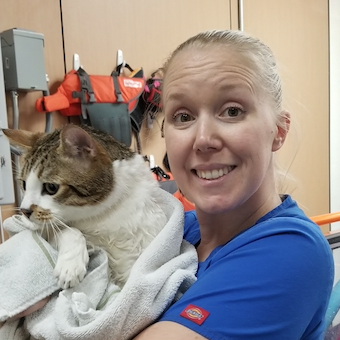Key Takeaway
Continuing education for veterinary technicians is not just a professional obligation. It is one of the most powerful investments a clinic can make in its people, its patients, and its future. When veterinary technicians are empowered to grow their knowledge, apply their skills, and pursue new passions, the ripple effect transforms entire teams. Stronger technicians lead to stronger medicine, better client relationships, and a healthier profession overall.
Vet Tech Week Aftermath
Every October, social media lights up with posts celebrating Veterinary Technician Week. Clinics order lunch, hand out gifts, and post heartfelt messages of gratitude. Those gestures matter. They remind every technician that their work is seen and valued. But appreciation cannot end when the week does.
Veterinary technicians keep practices running every single day of the year. They are the heartbeat of every clinic, balancing science, empathy, and precision in every interaction. So what happens when we go beyond appreciation and invest in their education and growth all year long?
At Hound, we believe the best way to celebrate veterinary technicians is by helping them continue to thrive. That’s why we’re launching free, RACE-approved continuing education (CE) webinars led by veterinary technicians, for veterinary technicians. Because no one understands the challenges and opportunities of this role better than those living it every day.
The Power of Tech-Led Education
When a technician teaches another technician, something special happens. Learning becomes more relatable, more honest, and more practical.
“CE led by Vet Techs is so powerful because it comes from someone who truly understands the day-to-day challenges of the role. When a tech teaches another tech, the lessons are practical, relatable, and immediately applicable—helping build confidence, improve patient care, and foster a sense of community within the profession.”
— Brian Goleman, CVT (@briansbandages)
That sense of peer connection turns continuing education into something more than a checkbox. It becomes a shared experience that builds camaraderie and confidence across teams.
“Continuing education for veterinary technicians is not just about learning new skills, it’s about advancing the quality of care we give to every patient. By investing in our growth, we strengthen our knowledge, our confidence, and our ability to serve both pets and their families at the highest level.”
— Peter Carlos, RVT, CVT (@petercarlosrvt)
“Your skills and knowledge won’t evolve unless you put the effort into your own education as medicine is constantly changing. You miss out on a lot of opportunities to provide the best level of care to patients if you cease to put the effort into your own self.”
— Ellen Carozza, LVT, VTS (CP-Feline) (@thecatlvt)
When technicians feel empowered to keep learning, they grow into confident advocates for patients and trusted partners in care.
Education Fuels Utilization
According to the American Animal Hospital Association (AAHA) Compensation and Benefits Report, the annual turnover rate for veterinary technicians in clinical practice is 23.4 percent. Nearly one in four veterinary technicians leaves the field each year.
One of the top reasons for this? Underutilization.
Many technicians enter the field excited to apply their education but find themselves confined to routine tasks. When they are not encouraged or trusted to work to the full extent of their license, engagement plummets. Continuing education changes that.
When veterinary technicians receive advanced training, they gain confidence in performing higher-level duties such as anesthesia monitoring, dental procedures, and lab diagnostics. When doctors trust them to use those skills, the whole team benefits.
“Taking care of patients is hard work and can take its toll. When we provide time for technicians to remember why they do what they do, learn new skills, and connect with colleagues through continuing education opportunities, we empower them to take their career path into their own hands. They become more confident in the day-to-day tasks, helping to minimize unnecessary stress that can lead to burnout. Continued learning helps technicians foster critical thinking skills and adaptability so they can think outside the box and find solutions.”
— Melissa Evans, LVT, VTS ECC (@melissaevtsecc)
Proper utilization isn’t just about efficiency. It’s about trust. When a technician knows their knowledge matters, they feel valued and respected. That trust builds loyalty, teamwork, and long-term commitment.
Engaged Teams Deliver Better Outcomes
Education fuels engagement. Engagement fuels retention. Retention fuels better outcomes for patients, clients, and the clinic as a whole.
When veterinary technicians are given opportunities to grow, they bring renewed energy and curiosity to their work. They notice subtle changes in patient behavior, catch early warning signs, and communicate clearly with pet owners. These small details have a big impact on outcomes.
“Registered veterinary technicians are more than skilled hands. We bring years of education that help us understand the ‘how’ and the ‘why.’ Continuing education ensures we stay sharp, current, and valuable members of the veterinary team.”
— Anthony Marciano, RVT (@macaroni.rvt)
Educated technicians don’t just complete tasks. They anticipate needs. They think critically. They support doctors in decision-making and enhance every patient interaction.
It’s not just theory either. Studies show that companies with highly engaged employees score 81 percent higher in customer satisfaction, and that combining employee and client experience can increase revenue by up to 50 percent. In a veterinary setting, that means more satisfied clients, healthier pets, and a stronger reputation for excellence.
To read more about the evolving role of veterinary technicians in shaping modern practice, check out The Future of Work for Vet Techs.
The ROI of Education
Investing in education isn’t just the right thing to do—it’s also good business.
- Retention saves money: Replacing a single technician can cost thousands in recruitment, training, and lost productivity. The Frontiers in Veterinary Science study on burnout estimates the cost of turnover among veterinary technicians at roughly 933 million dollars per year across the profession.
- Efficiency increases revenue: Skilled technicians can handle advanced procedures and client communications, freeing veterinarians to focus on complex diagnostics and surgeries.
- Quality care builds loyalty: Clients recognize when a team is confident, knowledgeable, and compassionate. Educated technicians inspire trust, which keeps pet owners coming back and referring friends.
- Reduced errors save costs: Ongoing education reduces mistakes in anesthesia, lab work, and medication management. Fewer errors mean safer care and less liability.
“Advancements in medicine and research are constantly primed to outpace our years of education if we don’t keep up with it regularly. That’s what CE is for. Despite working in a dermatology specialty clinic for years, I’m sure a lot of the information regarding which antibiotics to use or what medicated shampoo is best has evolved. I know that the name of one of my favorite parasites has changed yet again!”
— Leif Hayden, RVT
In short, every dollar invested in CE has a measurable return in team stability, patient safety, and client satisfaction.
Incentivizing Education
Continuing education doesn’t have to be complicated or costly. The key is to make learning a consistent part of clinic culture.
Here are some ways to incentivize growth and engagement:
- Enable CE preference: Encourage employees to grow in the areas they’re passionate about while supporting the hospital’s priorities, such as dentistry, anesthesia, or patient communication.
- Provide CE stipends: Cover the cost of CE credits, conferences, or online learning platforms.
- Create career pathways: Offer advancement opportunities for Lead Technician, Supervisor, or Specialty Technician roles.
- Reward growth: Recognize team members who complete CE or gain new certifications with preferred shifts, wellness days, or extra paid time off.
- Celebrate achievements: Highlight educational milestones publicly, in meetings or online.
“Investing in our continuing education is not only beneficial for us in our current roles, but it can pave the way for our future paths as well! You never know which bit of knowledge will pique your interest and potentially lead you down a new and exciting path. This happened to me when learning more about the marketing side of veterinary medicine, and now I have a fulfilling career in a part of the vet space I never envisioned for myself—all thanks to CE!”
— Amber LaRock, LVT (@vettechandtravel)
Simple recognition reinforces that learning is valued. When growth is celebrated, curiosity flourishes.
You can explore more ways to celebrate and support your team in Celebrate Vet Tech Week: Ideas to Appreciate Your Veterinary Technicians.
Mentorship Multiplies Impact
Continuing education provides knowledge. Mentorship helps apply it.
Pairing experienced technicians with newer hires builds confidence and consistency. Mentorship accelerates learning and strengthens retention because it fosters belonging and collaboration.
- Peer mentorship: Partner new technicians with experienced ones for guidance and support.
- Cross-training: Encourage techs from different departments to teach each other specialized skills.
- Structured programs: Create six or twelve-month mentorship plans that include milestones and feedback sessions.
- External networks: Connect your technicians with outside mentors through professional associations or virtual CE communities.
“Our education doesn’t stop after we graduate or take the VTNE. Continuing education reminds me that there’s always more to learn, or a skill I can sharpen. The more I learn and practice, the more confident and compassionate I can be in the moments that matter most. Change in medicine, in life, is constant. Continuing education keeps me feeling capable and confident to help the pets and pet parents we serve.”
— Meaghan Mcelroen
“Veterinary medicine moves forward only when our whole team does. Investing in technician education isn’t just about professional growth: it’s about elevating patient care, strengthening teams, and securing the future of our field. When I feel confident in my knowledge on a disease process, new procedure, or diet, I know I am being the best advocate for my patient.”
— Lucy Nash, RVT (@lucylupoprvt)
Mentorship connects learning to purpose. It transforms education from information into wisdom.
Where to Find Continuing Education Opportunities
Veterinary technicians today have more CE options than ever before, both online and in person. Here are some top providers that offer trusted, RACE-approved courses and programs:
- Hound VetTech Series: Offers free RACE-approved webinars for veterinary technicians.
- VETgirl: Subscription-based CE with an extensive on-demand library and live events for technicians and veterinarians.
- VetMedTeam: Offers free and paid RACE-approved courses for veterinary technicians.
- Vet and Tech: Free online CE webinars, including technician-specific topics.
- NAVTA Continuing Education Resources: The National Association of Veterinary Technicians in America’s hub for CE links and resources.
- IDEXX Learning Center: Free CE modules focused on diagnostics and laboratory medicine.
- MedVet Continuing Education: Free and paid CE opportunities for technicians and veterinarians.
- Merck Animal Health Webinars: Offers webinars that are often applicable to technicians in practice.
- Purdue University College of Veterinary Medicine: University-backed online CE programs.
- AAVSB RACEtrack: A tool to track CE credits and find approved courses.
If you’re looking to grow your career or explore specialty paths, check out Different Types of Veterinary Technician Specialists to learn how CE can open doors to new and exciting specialties.
When Vet Techs Thrive, Everyone Thrives
As we celebrate Veterinary Technician Week and every week beyond it, let’s make a collective promise: to move beyond appreciation and toward empowerment. Continuing education is more than skill-building. It is the foundation for stronger teams, healthier practices, and a brighter veterinary future.
When veterinary technicians have access to education, mentorship, and growth opportunities, they bring that energy back to every patient and every client.
At Hound, we believe education is not an expense. It is an investment in the people who make veterinary medicine possible.
Join Hound’s free, RACE-approved CE webinars and take the next step toward building a profession that grows together. Because when vet techs thrive, everyone thrives.
Frequently Asked Questions
1. How often should veterinary technicians complete continuing education?
Each state has its own CE requirements. Many require between 10 and 20 hours every two years. Regardless of regulation, ongoing education should be an annual goal for any technician seeking to stay current and confident in their role.
2. What does “RACE-approved” mean?
RACE stands for the American Association of Veterinary State Boards’ Registry of Approved Continuing Education. A RACE-approved program meets quality and educational standards recognized across most states.
3. How can clinics encourage technicians to pursue CE?
Offer CE stipends, flexible scheduling, and public recognition. Support attendance at conferences, and host in-house learning events. Building CE into the work culture signals that learning is part of success, not an afterthought.
4. What types of CE are most valuable for veterinary technicians?
The best CE focuses on both technical and soft skills. Topics like anesthesia, dentistry, emergency care, leadership, and communication empower technicians to contribute more meaningfully to patient care and team dynamics.
5. How does CE affect patient care?
Technicians who engage in regular CE stay sharp, confident, and adaptable. They make fewer errors, communicate more clearly, and approach patient care with greater depth and understanding. The result is improved outcomes and a more compassionate client experience.




.gif)


